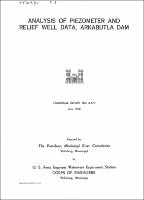Please use this identifier to cite or link to this item:
https://hdl.handle.net/11681/21485| Title: | Analysis of piezometer and relief well data, Arkabutla Dam |
| Authors: | United States. Mississippi River Commission U.S. Army Engineer Waterways Experiment Station |
| Keywords: | Relief wells Seepage Arkabutla Dam (Miss.) |
| Publisher: | U.S. Army Engineer Waterways Experiment Station. Engineer Research and Development Center (U.S.) |
| Series/Report no.: | Technical Report;no. 3-479 |
| Abstract: | Summary: Arkabutla Dam is a flood-control dam on the Coldwater River about 4-1/2 miles north of Arkbutla) Mississippi. The embankment is of rolled fill construction) has a maximum height of 74 ft) and is 6500 ft long. The foundation consists of 20 to 35 ft of relatively impervious clay and silt which are underlain by 30 to 60 ft of sand and gravel) underlain in turn by a stratum of impervious clay. The embankment is provided with a downstream pervious toe and a gravel drain to control through seepage) and a system of relief wells in the pervious foundation strata along the toe of the dam to control excess hydrostatic pressure that might otherwise exist in this area. Piezometers were installed to measure the hydrostatic pressure in the foundation along the downstream toe of the embankment. Results of observations of piezometers and measurements of relief well discharges are available for periods of high reservoir stages from 1945 to 1957. Analysis of the piezometric data indicates that the piezometric head) except in the vicinity of sta 190+00) has not exceeded 1 ft above ground surface along the toe of the embankment) even during a period when the spillway was discharging. A maximum excess hydrostatic head of 9 ft above ground surface occurred at sta 190+00; however) this head is not considered excessive. Analysis of the relief well flow indicates that the discharge of the relief well system per unit of net reservoir head has been decreasing steadily since 1946, although the unit discharge increases during very high reservoir stages, probably as a result of a flushing action. The decrease in well efficiency is not accompanied by a build-up in hydrostatic pressures in the pervious substratum along the embankment toe. This action is not attributed to ·silting of the reservoir as the yield from the wells increases considerably at high reservoir stages and therefore the effectiveness of the well system cannot be ascertained. It is considered that the effectiveness of the well system can best be determined by observing the piezometers while the wells are temporarily plugged. |
| Description: | Technical Report |
| Rights: | Approved for public release; distribution is unlimited. |
| URI: | http://hdl.handle.net/11681/21485 |
| Appears in Collections: | Technical Report |
Files in This Item:
| File | Description | Size | Format | |
|---|---|---|---|---|
| WES Technical Report No 3-479.pdf | 3.52 MB | Adobe PDF |  View/Open |